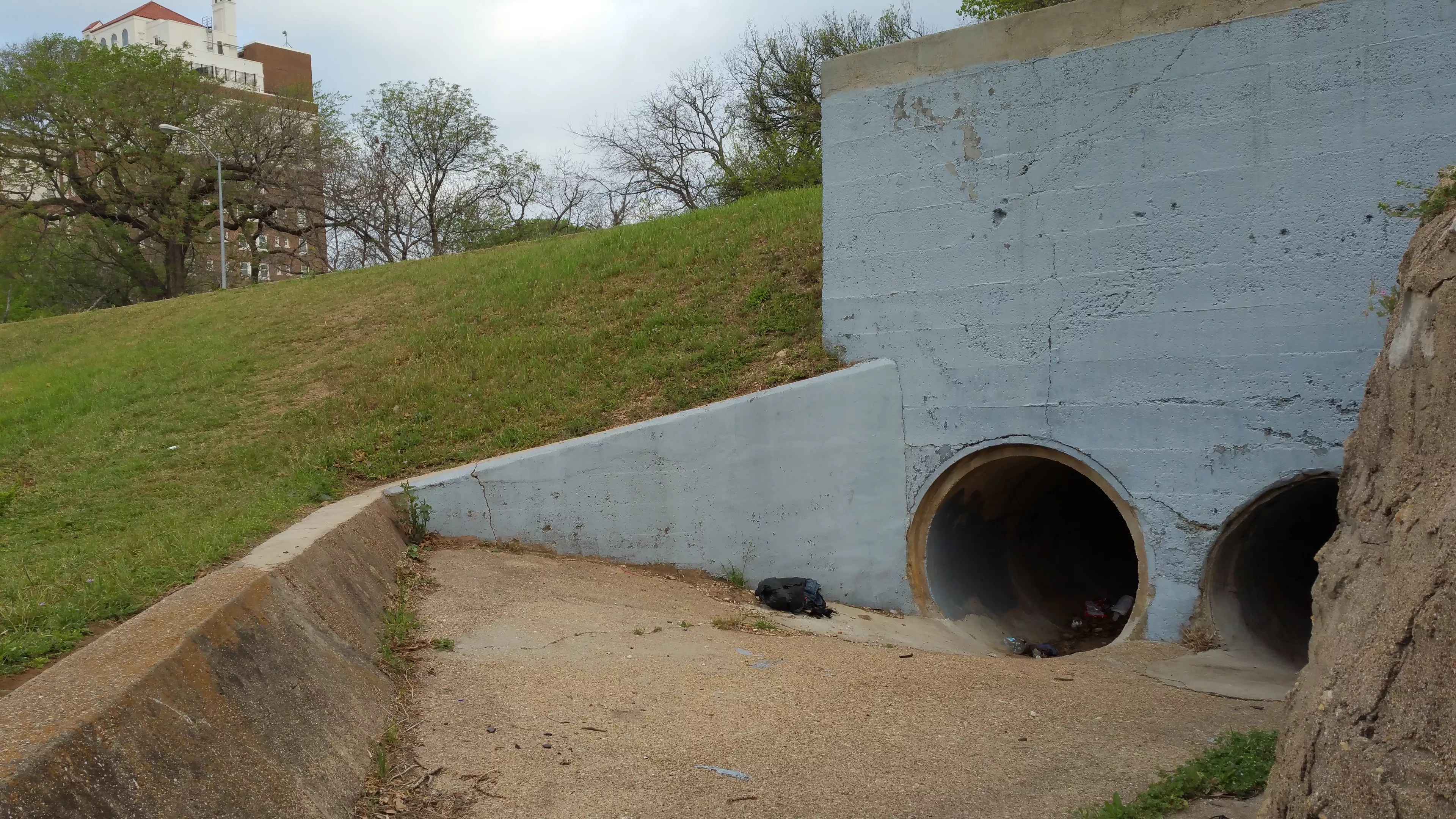
Joe Pappalardo

Audio By Carbonatix
Park Department employees spotted the man’s corpse in Lake Cliff Park on the morning of March 18, lying outside a drainage tunnel that police say he used for shelter. The initial police report says the man was wearing a hospital wristband and showed no signs of trauma. The medical examiner has determined the 64-year-old man’s identity, but officials are searching for a family member to notify before releasing his name to the public.
The only drainage pipes large enough to accommodate a person, Park Department workers in Lake Cliff Park say, are on the north side of the park. It’s almost exactly a mile around the lake, making it a popular place for joggers, dog walkers and bicyclists. A fountain in the lake is lighted at night, the display visible from the mouth of the pipes. The lake is attractive, and the water feature is pretty, but the lake is fouled with runoff from street drains.
Twin storm drains face the small, amoeba-shaped lake. The tunnel system is older than the deceased. First constructed in 1931, the tunnels were built to divert rising lake water through twin 4-foot-wide pipes that run under Colorado Boulevard. The tunnels open in Founders Park, just across the road. After heavy rain, the excess lake water would run to Founders Park and along an overflow bed that diverts the water to another, smaller drainage pipe.
There are signs inside the Lake Cliff drainage pipes that indicate recent habitation, or at least use: a plastic bag stuffed with clothes, a pile of unidentifiable material that could serve as bedding, food wrappers, crushed cans. And there was a blue walker wedged in one entrance.
“Clarence used a walker,” says Maria Gibson, a homeless woman who often sleeps under a raised parking platform connected to these Oak Cliff parks. “I hope it’s not him.”
Dallas, make your New Year’s Resolution Count!
We’re $10,000 away from reaching our $30,000 year-end fundraising goal. Your support could be what pushes us over the top. If our work has kept you informed, helped you understand a complex issue, or better connected you to your community, please consider making a contribution today.
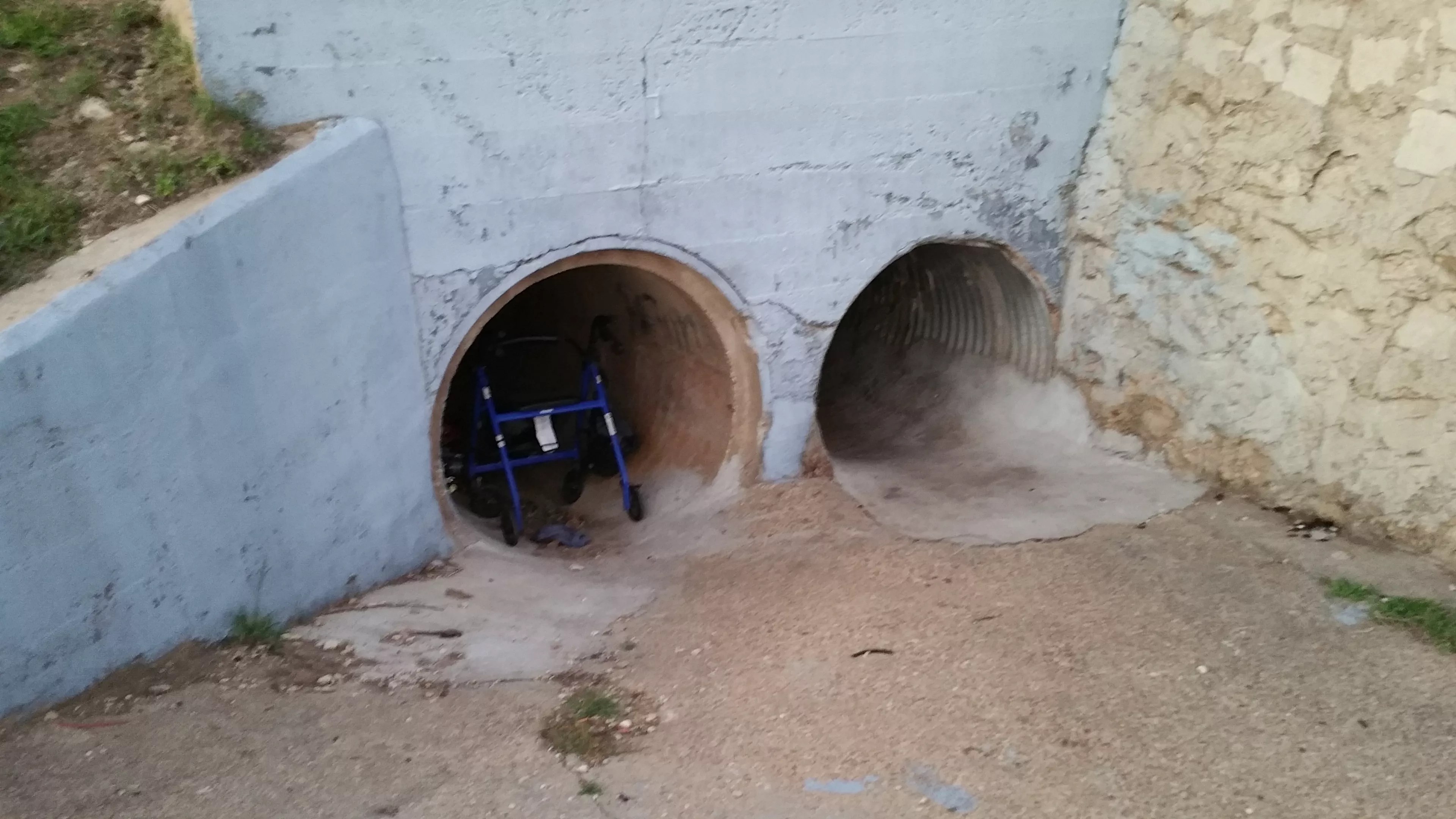
A walker left by the tunnels, seen here on Monday, led some to worry about the homeless man who used it.
Joe Pappalardo
John Foisset has lived adjacent to the lake for two years and has a good vantage of the neighborhood while on his stoop and walking his dog. “I see all the homeless people here, and I recognize these guys,” he says. “They’re not out here asking for money or hitting you up. The homeless people here are not really a problem.”
He makes a point to say that many of his neighborhood’s street people are low-key, but there are others he dubs “grizzles” who also populate the parks. They are younger, more aggressive, appear in bunches and only vanish after police chase them away. Some in the neighborhood link the arrival of these more intrusive homeless to last year’s shutdown of Tent City, a large homeless encampment near downtown Dallas.
One of the homeless people Foisset recognizes is an old man who would quietly haunt the lake at night. He first saw him one night at 2 a.m. while walking his dog. The old man was resting on his feet near the lakefront, using a blue walker to support his weight.
It’s possible he is the one the Park Department found dead this month, but even if the medical examiner releases a name, Foisset wouldn’t know it. He hasn’t seen the old man for a few months, and even that is a guess. The abandoned walker raises more questions than it answers. It stands mute as a headstone.
Oak Cliff Founders Park seems pleasantly quaint the day after employees find the body. Unlike nearby Lake Cliff Park, which is flat, Founders undulates in a number of small hills and shallow hollows. The main draw here is a disc golf course, and on an early Monday afternoon a handful of players are already tossing discs.
One of them, a stout bearded man in his late 20s, is playing a round by himself. “There are always guys hanging around here,” he says, asking that his name be withheld because he lives nearby. “And some are bad dudes.”
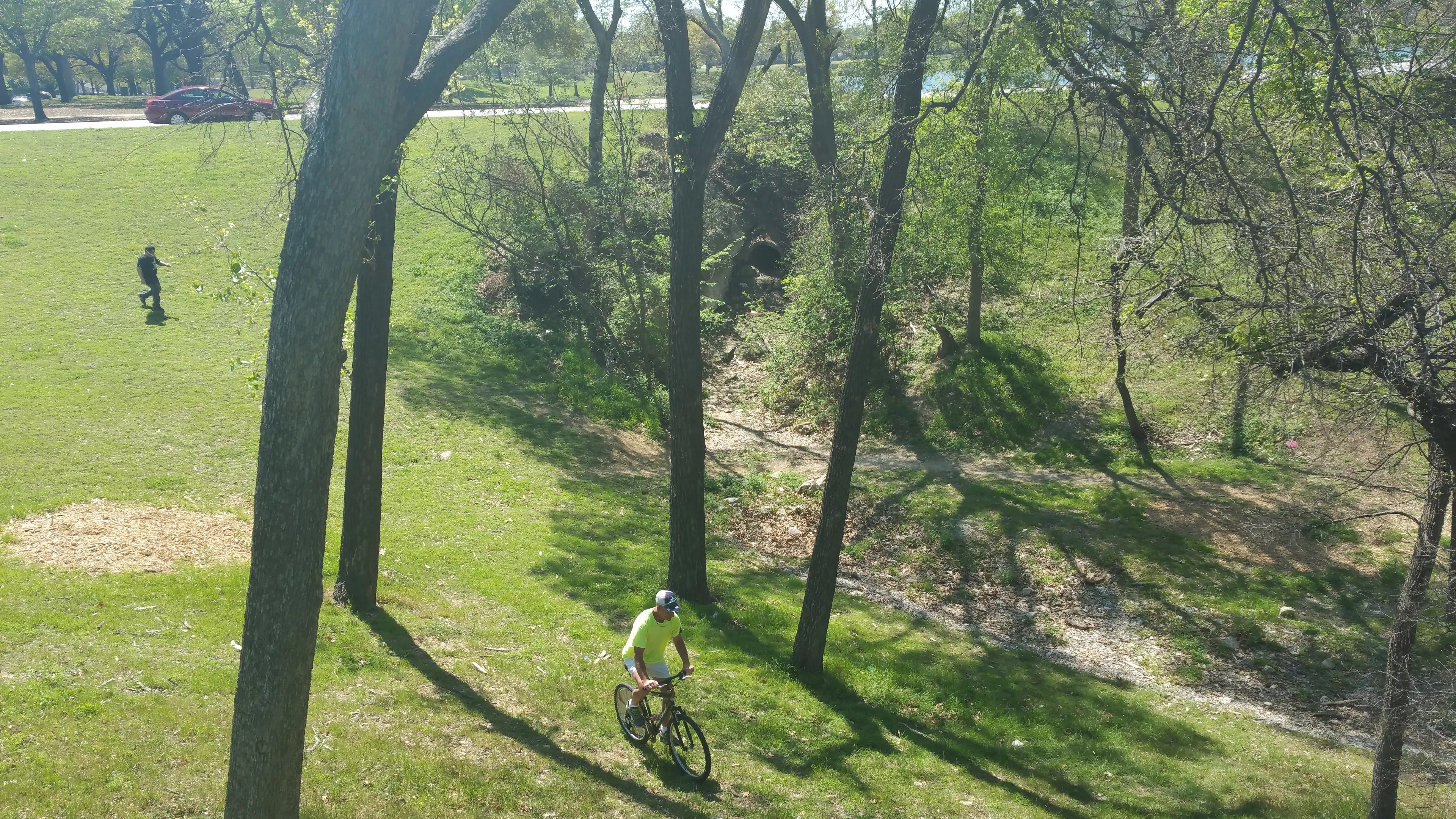
The drainage tunnel where Anthony Green lived (top, center) can
Joe Pappalardo
The disc golfer knows the location of the drainage pipes that connect to Lake Cliff, and he doesn’t like them. There are two of them, located side by side between the seventh tee and the basket. “When I play with my daughter, I have to scout ahead to make sure there’s no one down there,” he says. “One time a man in there growled at her, yelled like an animal to scare her.”
He’s not the only one leery of the storm drainage openings. Around dusk, Tim Lafata and Christie Moore are ready to play the seventh hole. Before they throw, the couple walks up a hill to a wooden platform that overlooks the park and affords a view of the storm drains. “This is the sketchiest part of the course,” Lafata says. “That’s why we come up here and look.”
Moore recalls an encounter one recent afternoon with a young man in hippie-style pants who surprised her while she played the hole by herself. Moore says she didn’t think the man was living in the park or necessarily even on the streets. “He didn’t look filthy,” she says.
“We don’t see them, but they are there. They are not after our company.”
The young man stepped out of the wooded area that obscures the drainage pipes and continued to stalk around the park. “It kind of freaked me out,” she says.
The storm drain tunnel on the Oak Cliff Founders Park side is obscured from nearly every direction. The bend of a runoff bed, lined with rocks and chicken wire, ends at twin concrete holes positioned alongside each other like a double-barreled shotgun. Each opening is about 4 feet in diameter.
There are signs of habitation, or at least of use. Trash is scattered here and there, mostly a few candy wrappers, food containers and beer cans. A couple plastic bottles are filled with yellow fluid, which can be safely assumed to be urine from those who dwell inside the tunnel.
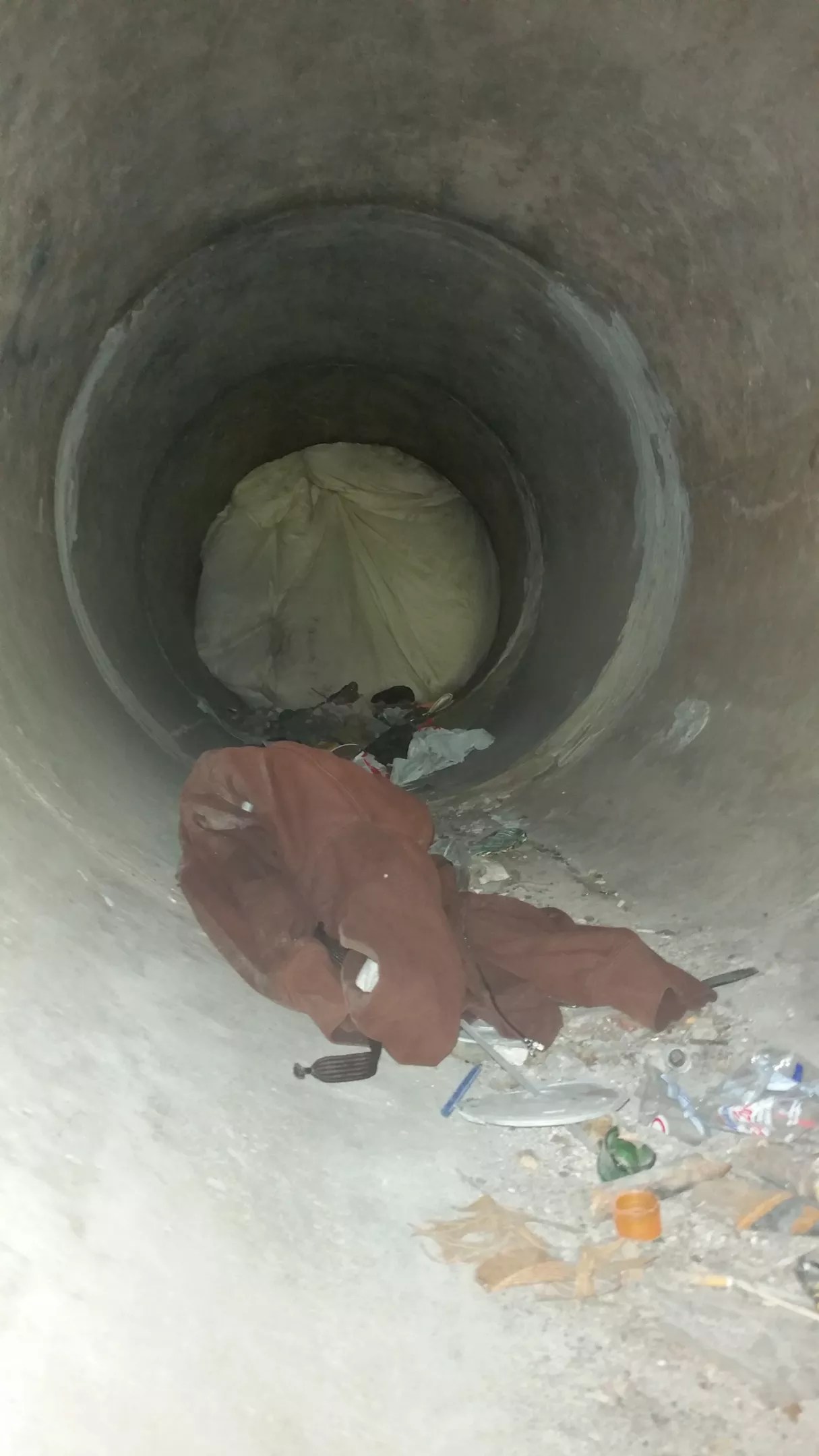
A dozen feet inside the tunnel, entering from the Oak Cliff Founders Park side. Previous tunnel residents say the obstruction helps control mosquitoes.
Joe Pappalardo
It takes a deep crouch to enter the tunnel. The inside walls are tattooed with faded graffiti. Broken glass crunches underfoot. A trail of detritus extends deeper into the tunnel – crushed cans, filthy clothes and food wrappers. A pair of tattered sneakers lie haphazardly on the concrete, laces removed and tongues hanging.
The tunnel seems only to be a temporary shelter until you get about 15 feet inside. There, someone has plugged the hole with what looks like a massive white comforter. Calling out yields no response. The air pressure changes and the white wall of the comforter swells with what eerily looks like breath.
The dirty white comforter marks some sort of divider between here and the lakeside entrance. It’s infrastructure, and therefore a sign of more permanent occupancy.
Maria Gibson says she took a bus from Virginia to Dallas three months ago to start a new life. She lives on the streets, and one of her frequent refuges is in a narrow sliver of space between the ground and the raised parking lot of a park-side Oak Cliff condo building.
The space is only accessible by scaling a steep incline, but it has evidence of a more permanent occupancy. Sleeping bags, a cooler and some spare shoes sit off the ground on a concrete lip. An abandoned syringe lies in the dirt, away from the makeshift bedded area.
“It’s good up here. It keeps us hidden,” Gibson says. “Sometimes we’ll sleep here, other times we’ll go to a shelter for a change of pace.”
Gibson is a plainspoken, late middle-aged woman, rail-thin and warily friendly. She left her grown children in Virginia and came to Texas in January, hoping the change of scenery would motivate her to, she says, “do what I need to.” She’s eyeing a job fair at the month’s end in hopes she can find a position at a Walgreens or Market Cafe.
Off the bus, Gibson first went to the Bridge Homeless Recovery Center in downtown Dallas. There she met a friend, and the two women watch out for each other. “Out here, you need that,” she says. “You got to have somebody.”
Gibson hadn’t heard of the corpse found nearby, but from the description she wonders if it’s the man called Clarence. “He’s the only one around here who used a walker like that,” she says. “He’d sleep over by the lake, or in the bathrooms, or in the bungalow.”
The bungalow is what some homeless call the Founders Park plaza, which the Friends of Oak Cliff Parks says was built in 1974 and “offers breathtaking views of the city of Dallas skyline.”
Gibson remains wary of these parks, especially the Lake Cliff side. “I heard that it gets crazy there, with fights and everything,” she says. “I used to go over there, but I’ve seen enough. People I don’t even know asking if I want to party.”
She says the best part about their spot under the garage is that she and her friend can’t be seen. When the pair bend down in the narrow space, they make sure no one can see them scale the incline, whether it’s police or other homeless people. “We’ll wait until it’s clear before going into the hole,” she says.
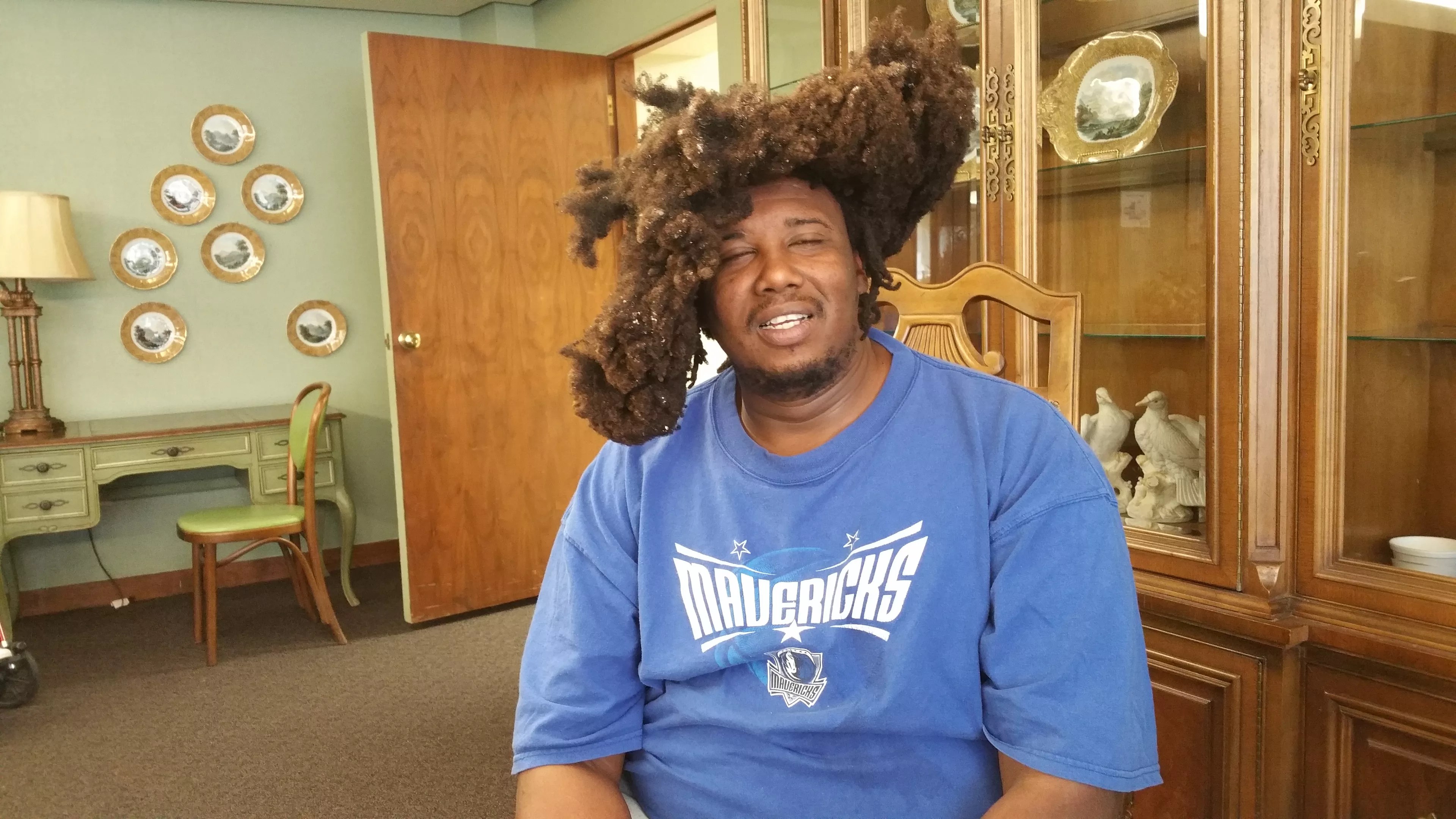
Anthony Green, who lived in the Oak Cliff park nooks and tunnels for several years, volunteers his time at a nearby church (where this photo was taken) and still lives on the streets.
Joe Pappalardo
Anthony Green lived in the Founders Park side of the tunnel for years. He drifted to the Lake Cliff Park, where he slept in various drainage tunnels, park pavilions and the base of trees, in 2009, after being chased away from the underpass where he slept. “I was up by I-30, under the highway, then the city got me gone,” he says. “I spent a while on the lake side, but it was crazy there. I moved to the pipe then.”
Green is a heavyset, soft-spoken man crowned with wild, flat dreadlocks. He squints a lot, almost constantly. A smile comes quickly to his face and, for someone who is so shy, he seems content to share his experiences as a homeless man in Oak Cliff. Even though he sometimes trips up phrases and loses his train of thought, his take of life on the streets is almost philosophical. “I’m trying to be an individual that’s working on my inner spirituality kind of thing,” he says. “Let me be myself and see what happens.”
Green is a born-and-bred Dallasite. His last permanent home was in North Dallas, where his mother still lives. He says they got along, but he doesn’t want to burden her since she relies on Social Security to live. It’s his mantra – to be left alone and free of external pressures.
“I just don’t feel comfortable asking for help. Some people call it pride.”
“I never go downtown. I’ve never been to the Bridge,” he says. “I just don’t feel comfortable asking for help. Some people call it pride. I don’t seek out people, but I wait for generosity to come to me.”
He left Lake Cliff and found the overflow tunnel in Founders Park, which he enjoyed because he could be left alone by police and other homeless people. He installed a pallet, scrounged a bedspring and mattress and made it a home. He says the setup allowed rainwater to run under his bed.
He smiles when he sees a photo of the white obstruction in the tunnel. “Yeah, we set that up to keep mosquitoes away,” he says. “Didn’t work too well.”
Hearing that the tunnel appeared to be empty, Green says it’s too good a spot to remain unused. “Just because they can’t be seen, that doesn’t mean no one’s there,” he says.
For all his desire to separate himself from the world, Green says he also has an impulse to be productive.That’s how he crossed paths with Friends of Oak Cliff Parks volunteer Anne Marie Bristow. She speaks fondly of Green, who helped her weed flowerbeds and set up butterfly stations.
“He was a great guy,” she says. “He lived in those tunnels in Founders Park. He had a cardboard box down there with all of his stuff in it. People complained, and they took all of his stuff, removed all the trash. But it was his belongings. I bought him a new toothbrush.”
Bristow is a semi-retired civil engineer. She used to work in industrial design until manufacturing went overseas and now makes money with the occasional commercial property project. Her real passion is re-wilding urban spaces and installing plants in public parks. As an Oak Cliff resident for 17 years and a parks volunteer, Bristow has extended contact with the homeless. “They are like coyotes,” she says. “We don’t see them, but they are there. They are not after our company.”
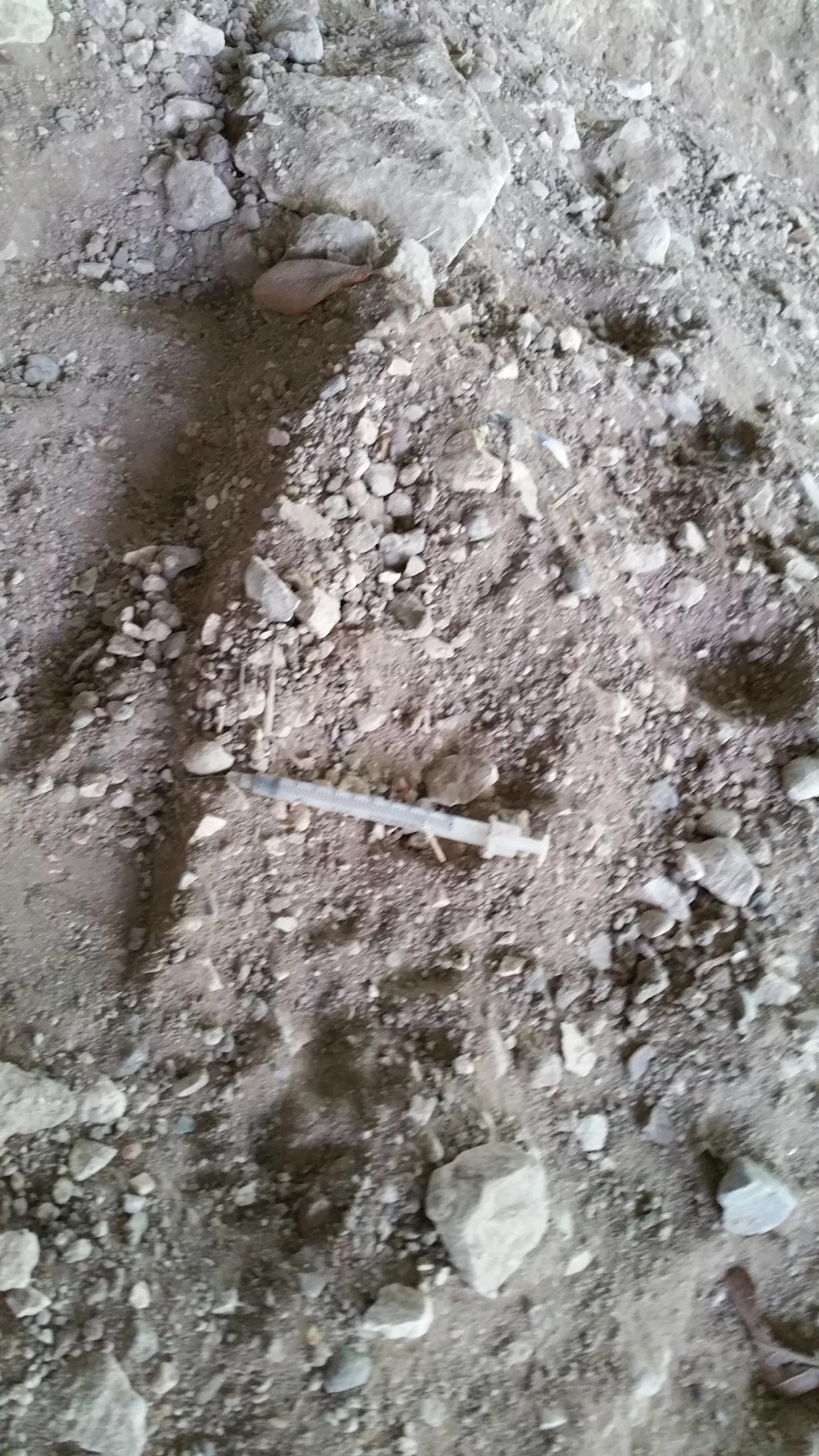
A syringe in Oak Cliff Founders Park
Joe Pappalardo
Green says the city did clean out his belongings, but he doesn’t seem mad about it now. He says it comes with being homeless and is bound to happen. Besides, it wasn’t pressure from the city that made him leave the park; it was other homeless people.
“It was a year before they found me,” he says. “You know, if you have something good, as good a setup as you can get when you’re on the streets, other people hear about it and want it, too.”
Other homeless people would come over to the tunnel and overstay their welcome. Green first tried to escape them by spending more time deeper in the pipe, but he didn’t like to venture more than 30 feet inside. He says that the tunnel, since it’s out of view, is an attractive place for addicts to do drugs. “Not so much weed, but crack and ice that they can buy two blocks away,” he says.
The new arrivals ruined his peace of mind. “The people around you made the world look worse to me,” he says. “It’s kind of depressing, when you want to be good and you’re surrounded by evil. It’s not even so much what they do, but what they say. Some of them, they don’t like people.”
Bristow says the conditions are worse since last spring when the city shut down Tent City, located under an I-30 overpass near downtown. Displaced homeless people spread out across the city looking for places to settle. That included Oak Cliff Founders Park and Lake Cliff Park.
Bristow says the new homeless population is more desperate and intrusive. “The people from Tent City are beyond caring,” she says. “Before, the people here were neither aggressive nor destructive. There’s a big difference.”
Green agrees with the distinction between the lake side homeless and the former residents, but doesn’t blame Tent City. For him, the cycle of intrusion from the other homeless is just part of the ebb and flow of life on the street.
Now, he stays away from Lake Cliff and Founders parks entirely. His friends have drifted away, and he doesn’t want to run into the strangers who live there now. “I can’t go over there anymore,” he says. “I just view it from far off. I don’t want to meet people.” He calls Bristow a “real nice lady” and says he may visit her soon, but there’s already doubt in his voice. After all, he doesn’t visit his mother, and she’s presumably still living in Dallas.
Green now sleeps behind a store in Oak Cliff. He spends many of his days at the Well Community, a mental health program run by Cliff Temple Baptist Church. There, he does whatever tasks need to be done, from cleaning the rooms to pushing people around in wheelchairs.
Bristow says her friendship with Green has changed her outlook on the homeless and shattered her perception that everyone on the streets wants a permanent home. Some people, she says, want to live on the street, and she is inclined to accommodate them. “Anthony and his buddies used to get together and cook at the grills, if someone gave them meat or potatoes or something,” Bristow says. “I think they have a right to be here. Anthony would say, ‘This is our home.’ Who am I to say that it’s not?”
The medical examiner’s office says the body of the man found in the drainage pipe has been identified. The city does not make names of the deceased public until their next of kin is notified. No one has seen Clarence around, so worry for him persists, but the name of the dead man at the Medical Examiner’s office is not Clarence. Did he use a street pseudonym or is it someone else? On the streets, things are always fluid, shifting, hard to pin down.
The medical examiner’s office says they are waiting for a toxicology report to rule on a cause of death. That will take at least six weeks. Even before the report comes back, if the medical examiner has exhausted all attempts at finding a family member, the man will head to the crematorium that UT Southwestern runs near their hospital.
Meanwhile, it’s a typical morning at North Oak Cliff’s parks. At 8:30 a.m., people are taking morning jogs around Lake Cliff. Tired dog owners stroll with their relieved, bright-eyed canines. A young woman in jeans rides a longboard down the parks’ smoother inclines. Gibson rises from her sleeping bag, goes to 7-Eleven for fresh water and then makes her way to the DART station, headed for downtown.
In Founders Park, the drainage pipe that Anthony Green called home shows signs of occupancy. There’s food wrappers, water bottles and clothes strewn outside the pipes. The food wrappers and bottled water appear to be fresh, while some of the older clothing and water-logged materials seem to have been ejected from the tunnel.
There’s a sleeping bag barely visible in the tunnel’s gloom. A face appears from one end of the bag, one eye seemingly closed shut. The man identifies himself as J.R. “We came in from San Antonio,” he says. J.R. and his brother and sister came to Dallas on a bus on Monday and quickly identified the Oak Cliff parks as a place of refuge. The three are sheltering in the tunnel, but this morning he’s alone. “I don’t know where they are,” he says, still prone.
He asks for cigarette, doesn’t get one, and puts his head back down. Just over a week after the park maintenance workers found the corpse nearby, the Oak Cliff Park drainage pipes have new denizens.
On the other side of Colorado Boulevard, where the tunnels face the lake, the pipe where a man sought shelter for the last time appears as empty as it did the day after he died. Except now, even the blue walker is gone.
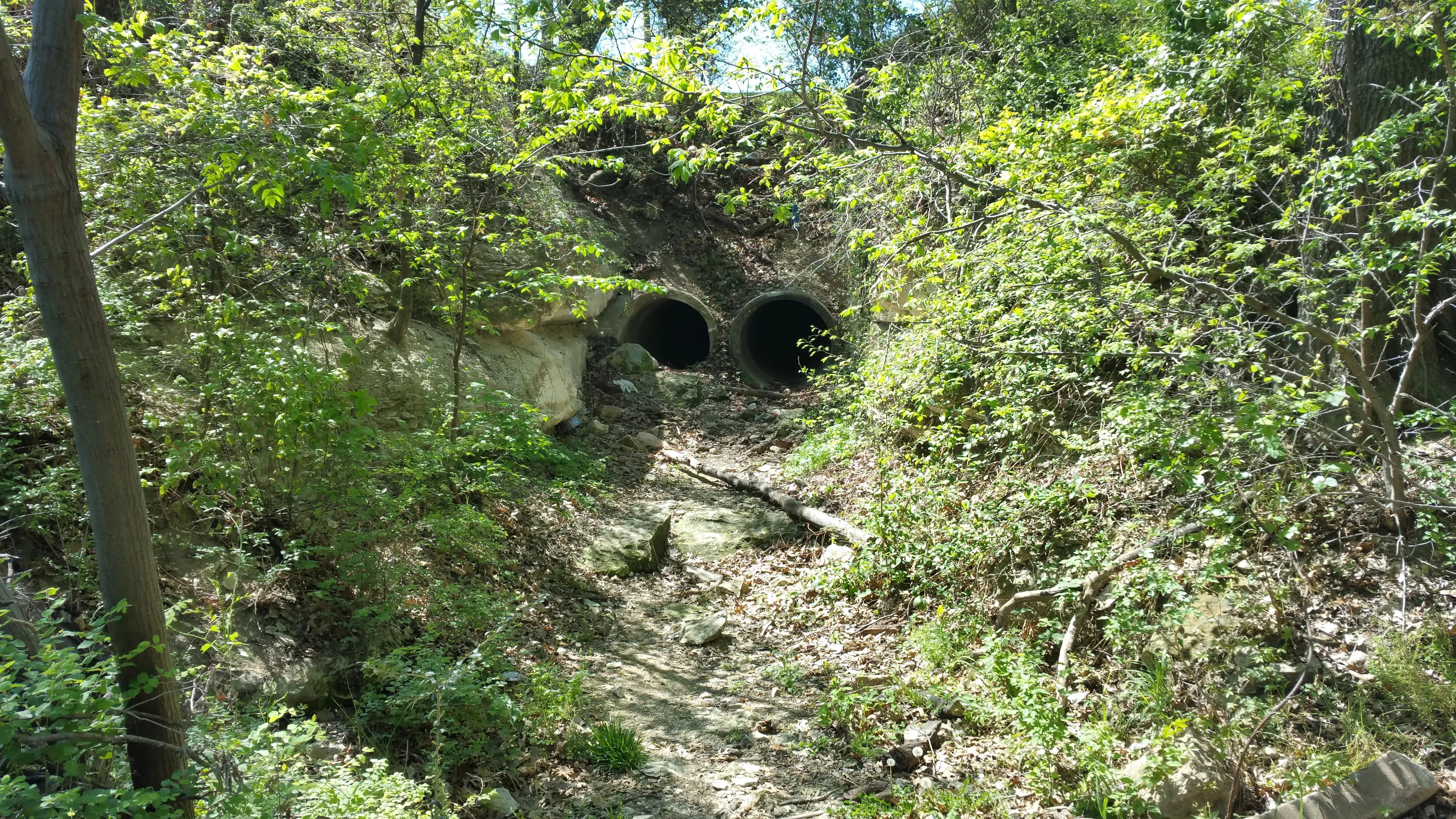
The outside of the tunnels where Anthony Green lived.
Joe Pappalardo